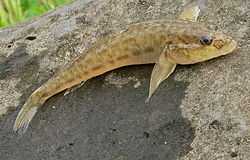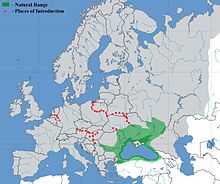Monkey goby
| Monkey goby | |
|---|---|
 | |
| Conservation status | |
| Scientific classification | |
| Kingdom: | Animalia |
| Phylum: | Chordata |
| Class: | Actinopterygii |
| Order: | Perciformes |
| Suborder: | Gobioidei |
| Family: | Gobiidae |
| Subfamily: | Benthophilinae |
| Genus: | Neogobius |
| Species: | N. fluviatilis |
| Binomial name | |
| Neogobius fluviatilis (Pallas, 1814) | |
 | |
| The range of the Monkey goby | |
| Synonyms | |
| |
Neogobius fluviatilis, the monkey goby, is a species of goby native to the basins of the Black Sea and the Sea of Azov.
Characteristics
The monkey goby is covered with cycloid scales on the head crown, nape, back, one third of the gill covers, bases of the pectoral fins, and the posterior half of the throat and belly. Its second dorsal fin is small in size compared to the posterior end of the body. The width of its head is equal to or a bit greater than the height of the head, and terminates in an acuminated, or leaf-shaped, snout. The jaws of Neogobius fluviatilis contain small, conical teeth and the mandibles are set forward in the skull. The abdomen of the monkey goby is lined with suckers that stretch from the collar to the anus. Its coloration is a brownish gray or a yellowish gray, usually with a very pale brown pattern of dark merged spots. Rows of dark spots are also found on the dorsal and caudal fins. The average adult monkey goby measures 7–10 centimeters, but has been known to grow to lengths of 18–20 centimeters. This species weighs around 50 grams.
Range
The natural habitat of the monkey goby is the fresh and brackish waters of basins in the Black Sea and the Sea of Marmara.[2] In the basin of the Sea of Marmara, it is a common sight in Manyas, Sapanca, and the Kazoli River in Bosporus Strait. In the Black Sea and the surrounding areas, the monkey goby is common in all desalinated water including the Danube river and its tributaries, the lagoons and estuaries of the north-western part of the Black Sea, the Sea of Azov, and the rivers of Caucasus. Recently, the monkey goby has been registered as an invasive species in some countries of Europe. In 1970, the species was first declared as a non-indigenous in Lake Balaton in Hungary.[3] The monkey goby was discovered in the Middle Danube in Hungary in 1984.[4] In 2001 it was found to have spread to the Slovak-Hungarian sector of the Danube River.[5] In the basin of the Baltic Sea it was first registered as an invasive species in 1997.[6] The species has also become a common sight in the Włocławek Reservoir and Zegrze Reservoir.[7] The monkey goby has been found in the German part of the river Rhine since March 2009. It has also been found in the Waal River, near Nijmegen, the Netherlands.[8]
In August 2011 the monkey goby is registered for the first time in the Evros River (Greece), which is inflows to the Aegean Sea.[9]
Feeding
The monkey goby belongs to the group known as malacophages, but molluscs have lower importance in its diet than in that of the round goby.[10] However, in the Sea of Azov molluscs (mainly Abra segmentum) make up 85% of its diet.[11] In the Gulf of Tendra its diet is dominated by polychaetes, the larvae of Chironomidae, molluscs, Cerastoderma, juvenile gobies, adult marbled gobies, and crustaceans such as amphipods and shrimp.[12] In the Danube lakes Yalpug and Kugurluy, the diet of the monkey goby consists of amphipods, molluscs, and Oligochaeta.[13]
In the Khadzhibey Estuary a dozen species of prey make up the diet of monkey goby.[14] Polychaetes, larvae of insects, and shrimp are present in the diet year round. Seasonal dietary additions include crabs such as Rhithropanopeus harrisii, sea weed such as Zostera marina, and amphipods such as Marinogammarus olivii. Certain planktonic crustaceans are also present in the diet of adult gobies.
Parasites

In the northwestern Black Sea, twelve parasite species are known to infect the monkey goby.[15] The core of the parasitic fauna are a trio metacercariae composed of Сryptocotyle concavum, Сryptocotyle lingua, and Рygidiopsis genata. Other common parasites include the nematode Dichelyne minutus and the cestoda Ligula pavlovskii. The trematode parasites C. lingua and P. genata can also infest humans.[16][17] In the 1950s, along the coast of the Gulf of Taganrog in the Sea of Azov, the monkey goby was registered as a host of epizootic of nematodes Tetrameres fissispina and Streptocara crassicauda, which are fatal to ducklings.[18]
Importance
In Ukraine the monkey goby is a crucial commercial fish, especially in the Sea of Azov and Dnieper-Bug Estuary. It plays an important role in the food chain by serving as prey for other predatory fish living in these areas.
See also
References
| External identifiers for Monkey goby | |
|---|---|
| Encyclopedia of Life | 1156461 |
| ITIS | 172069 |
| NCBI | 320562 |
| WoRMS | 293634 |
| Also found in: FishBase | |
- ↑ Freyhof, J. & Kottelat, M. 2008. Neogobius fluviatilis. In: IUCN 2013. IUCN Red List of Threatened Species. Version 2013.1. <www.iucnredlist.org>. Downloaded on 09 September 2013.
- ↑ Smirnov A.I. (1986) Perch-likes (gobiids), scorpionfishes, flatfishes, clingfishes, anglerfishes [in:] Fauna of Ukraine, Vol. 8, No 5, Kiev: Naukova Dumka, 320 pp. (in Russian)
- ↑ Bíro P. (1971) Neogobius fluviutilis in Lake Balaton - a Ponto-Caspian goby new to the fauna of central Europe. J. Fish Biol., 4: 249-255.[http://onlinelibrary.wiley.com/doi/10.1111/j.1095-8649.1972.tb05671.x/abstract?systemMessage=Due+to+scheduled+maintenance+access+to+the+Wiley+Online+Library+may+be+disrupted+as+follows%3A+Saturday%2C+30+October+-+New+York+0500+EDT+to+0700+EDT%3B+London+1000+BST+to+1200+BST%3B+Singapore+1700+SGT+to+1900+SGT.]
- ↑ Pintér K. (1989) Fishes of Hungary. Akadémiai Kiadó, Budapest, 202 pp.
- ↑ Stráňai I., Andeji J. (2001) Monkey goby – (so far) the last invasing species from the gobiids family. Polovnictvo a rybárstvo (Bratislava), 53: 44-45.
- ↑ Danilkiewicz Z. (1998) Babka szczupła, Neogobius fluviatilis (Pallas, 1811), Perciformes, Gobiidae – nowy, pontyjski element w ichtiofaunie zlewiska Morza Bałtyckiego. Fragm. Faun., 41(21): 269–277.
- ↑ Kostrzewa J., Grabowski M. (2002) Babka szczupła, Neogobius fluviatilis (Pallas, 1814), w Wiśle - fenomen inwazji pontokaspijskich Gobiidae. Przegl. Zool., 46(3-4): 235-242.
- ↑ van Kessel N., Dorenbosch M., Spikmans F. (2009) First record of Pontian monkey goby, Neogobius fluviatilis (Pallas, 1814), in the Dutch Rhine. Aquatic Invasions, 4(2): 421-424.
- ↑ Zogaris S., Apostolou A. (2011) First record of Pontian Monkey Goby, Neogobius fluviatilis (Pallas, 1814) in the Evros River (Greece); is it an alien species? Mediterranean Marine Science, 12(2): 454-461.
- ↑ Andriyashev A.R., Arnoldi L.V. (1945) O biologiipitaniya nekotoryh donnyh ryb Chernogo morya. Zhurn. obshch. biol., 6(1): 53-61. (in Russian)
- ↑ Lus V.Ya. (1963) Pitaniye bychkov (sem. Gobiidae) Azovskogo morya. Trudy Instituta okeanologii, 62: 96-127. (in Russian)
- ↑ Borisenko A.M. (1946) Kolichestvennyj uchet donnoy fauny Tendrovskogo zaliva: Abstract of PhD Thesis, Karadag, 18 p. (in Russian)
- ↑ Grinbart S.B. (1964) Zhivlennia bentosoyidnyh ryb i kormovi resursy zoobentosu lymaniv (Yalpuh, Kugurluy) [In:] Tezy dop. I resp. konf. VGBT, 9, Kiev, Naukova Dumka, pp. 68-69. (in Ukrainian)
- ↑ Kudrenko S., Kvach Y. (2005) Diet composition of two gobiid species in the Khadzhibey Estuary (North-Western Black Sea, Ukraine). Acta Universitatis Nicolai Copernici, Limnological Papers, 24: 61-68.
- ↑ Kvach Y. (2005) A comparative analysis of helminth faunas and infection of ten species of gobiid fishes (Actinopterigii: Gobiidae) from the North-Western Black Sea. Acta Ichthyologica et Piscatoria, 35(2): 103–110.
- ↑ Youssef M.M., Mansour N.S., Awadalla H.N., Hammouda N.A., Khalifa R., Boulos L.M. (1987) Heterophyid parasite of man from Idku, Maryat and Manzala Lakes areas in Egypt. J. Egypt. Soc. Parasitol., 17: 474–479.
- ↑ Zimmerman M.R., Smith G.S. (1975) A probable case of occidental inhumation of 1600 years ago. Bull. N.Y. Acad. Med., 51(7): 828–837.
- ↑ Kovalenko I.I. (1960) Izucenie cikla razvitiâ nekotoryh gel’mintov domasnih utok v hozâjstvah na Azovskom poberez’e. Doklady AN SSSR, 133(5): 1259–1261.(In Russian)
Further reading
- Fishes of waters of Ukraine / Monkey goby (Neogobius fluviatilis (Pallas, 1814)) - in Russian
- Digitaler Fischertenatles von Deutschland und Österreich / Neogobius fluviatilis Pallas, 1814 - Flussgrundel - in German
| ||||||||||||||||||||||||||||||||||

